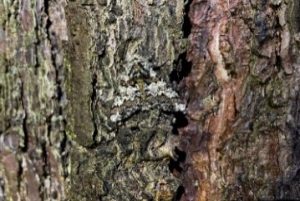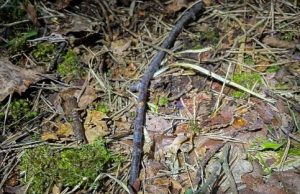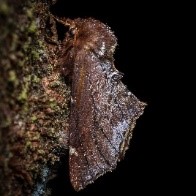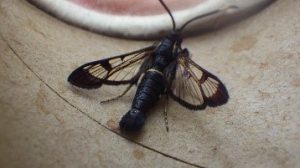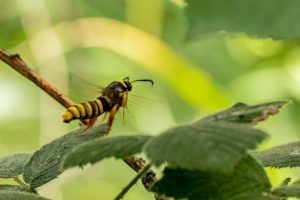Mike Halsey writes about Moth activity found at the Reserve during 2022
The winter months up to late February are the ‘flight time’ of many species of moths in which the female doesn’t fly at all – having either no wings, or wings that are stunted. Many of these species are common at Fleet Pond, with the caterpillars feeding on either oak or birch in the early Spring. Probably the best known is the Winter Moth, the caterpillar of which is a vital part of the diet of hatchling small birds, particularly Great Tits, in Spring . One of the common flightless females seen in early 2022 at Fleet Pond was the Mottled Umber (pictured below).
As part of the 2022 survey activities, a group of Pond Society members had a number of outings in the Spring and early Summer. They began at the end of March, after a run of hot weather resulting in what looked to be an early start to the Spring/Summer moth season, although this was put on hold somewhat by an early April cold spell.
At the end of March, a highlight was a Dotted Chestnut (pictured below) which, like many others of this family, hibernate in the Autumn and delay pairing and egg-laying until March/April.
Other species seen included Oak Beauty (pictured below top) at rest on a pine trunk and Purple Thorn (pictured below bottom).
Both moths show their wonderful camouflage on lichen or among the leaf litter.
While there weren’t many moths on a cold night in mid April, the highlight of the evening was a magnificent, freshly emerged Scarce Prominent (pictured below).
The summer season proper started in early June with a trip to Fugelmere Marsh to look for ‘Clearwing’ moths. These are day-flying wasp and hornet mimics that, until recently, have been difficult to find; however, the manufacture of artificial sex pheromones, imitating the scent released by a female moth in order to attract a mate, has made the job somewhat easier – at least for attracting males.
So far, we have been successful in finding seven species of Clearwing, including the nationally scarce White-barred Clearwing shown below top, and the Lunar Hornet Clearwing shown below bottom.
Meanwhile, light trapping has been very fruitful, with a number of important discoveries. Most notable has been a strong colony of the Dotted fan-foot moth, another nationally scarce insect of which there are few prior Hampshire records. We also saw several specimens of the Dentated Pug, the larvae of which feed in late summer on Yellow Loosestrife, a plant which grows relatively commonly in areas of the Reserve.
There will be more trips out at the Pond in coming months, both running lights at night and a range of other daytime activities including pheromones to attract clearwing moths. None of this would have happened if it hadn’t been for a couple of grants from Southern Coop, so a big ‘thank you’ to them.
Photos by Ana Peiro (Mottled Umber, Scarce Prominent, White-barred Clearwing, Dotted Fan-foot) and Emma Stephenson (Dotted Chestnut, Oak Beauty, Purple Thorn)



